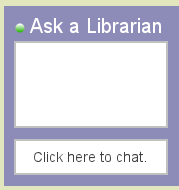Research Tools - Spring 1998
Citing the Internet Site - Revisited
- In the Winter 1996 issue of Information Update, I identified World Wide Web sites that gave suggestions on how to cite information obtained from the Web. These sites remain helpful. Since then, however, both the Modern Language Association and the American Psychological Association have developed Web sites that provide guidelines on citing information from the WWW.
- "MLA Style" (http://www.mla.org) provides examples on how to cite various Web sources. These include scholarly projects, professional and personal sites, books or poems, encyclopedia articles, journal and magazine articles, and postings to a discussion list. The site notes that their guidelines are ""the only ones available on the Internet that are authorized by the Modem Language Association of America." In addition to information on citing WWWW sources, "MLA Style" addresses two other issues. First, they indicate the number of spaces following punctuation can be either one or two. Second, they recommend underlining rather than the use of italics. MLA anticipates the release of a new edition of the MLA Style Manual in 1998 that will elaborate on citing WWW sources. There are two links from the APA home page (http://www.apa.org) that guide users on how to cite information obtained from the WWW These include "How to Cite Information from the Internet and the World Wide Web" and "Pub Manual FAQ." The first link provides examples of citations of announcements, articles, and abstracts obtained from APA's own Web page and applicable to other Web sites as well. It also answers a question frequently asked at the Reference Desk- how do you cite a Web site in the text of the paper. APA advises that "it's sufficient to give the address (e.g., http://www.apa.org)" in the body of the document without referring to the list of references, The "Pub Manual FAQ" also addresses the issue of spacing after punctuation (one not two), as well as how to indent references (use paragraph-type indent not hanging indent), and the use of underlining or italicizing sources (underlining is considered easier to read than italics). Like MLA, APA grants instructors the final word on how students should cite Web sources.
- Recommendations from both the MLA and the APA Web sites have been incorporated in the handouts available at the Library's Reference Desk. These handouts, "MLA-Style Bibliographic Format: Electronic Sources" and "APA-Style Bibliographic Format: Electronic Sources," remain important because they indicate how to cite full-text articles from InfoTrac, FirstSearch, and IDEAL, These three WWW services (all added to the Weinberg Library in the last year) provide not only citations to articles but the articles themselves. When printed, these articles include a Web address in the upper right hand corner. They resemble documents obtained directly from the Web and can be misleading. Students will have a tendency to cite these articles like Web sources when they are really online subscription service sources. This is a subtle distinction but an important one. References should lead the reader to the source of the document. If a full-text article from a WWW subscription service is cited as a Web document, the reader will not be able to retrieve the article from the Web address given. You cannot retrieve an article from InfoTrac, FirstSearch, or IDEAL without first connecting to the service. Students should cite documents from these sources following the recommendations for citing online services. These recommendations appear in the MLA Handbook, 4th edition, (pages 151-167) and the Publication Manual of the APA, 4th edition, (pages 218 -221). The handouts provide examples of articles from the Library's online services based on these recommendations.
- There continues to he a problem with in-text citations of full-text articles from online services. It is misleading to cite only the Web address. M.E. Guffey's Web sire (http://www.westwords.com/GUFFEYlapa.html) suggests a reference to the source as being online (e.g., Smith, 1997, online or Smith, 1997, http). This indicates to the reader that this is an online source and not to expect a reference to the page. The handouts include this recommendation.
- I have been monitoring WWW sites dealing with the issue of citing electronic sources and discussed the problem of citing full-text articles with representatives from MLA and APA. The handouts have been revised as changes occur. Preferences and suggestions from faculty are always welcomed and can be addressed directly to me at the Reference Desk or by e-mail (fennewaldjl@uofs.edu).
Joesph Fennewald

